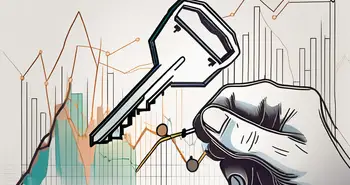How to Identify an Effective Entry Trigger

In this comprehensive guide, I will take you through everything you need to know about entry triggers, their various types, key components, strategies, common mistakes, and more. By the time you finish reading this article, you'll be well-equipped to spot the perfect entry trigger for your trading endeavors.
Understanding Entry Triggers
At its core, an entry trigger serves as a signal to initiate a trade. It helps traders determine the precise moment to enter a position, maximizing the potential for profit and minimizing risk. Essentially, an entry trigger is a game-changer in the world of trading.
What is an Entry Trigger?
An entry trigger is a specific condition or set of conditions that traders look for before entering a trade. It could be a combination of technical indicators, price action patterns, or fundamental factors. The purpose of an entry trigger is to provide clarity and confidence, ensuring that traders make informed decisions.
Let's delve deeper into the different types of entry triggers that traders commonly use:
Technical Indicators: Traders often rely on technical indicators such as moving averages, MACD (Moving Average Convergence Divergence), RSI (Relative Strength Index), or Bollinger Bands to identify entry points. These indicators help traders analyze price movements, trends, and market conditions, providing valuable insights into potential trade opportunities.
Price Action Patterns: Price action patterns, such as support and resistance levels, chart patterns (like triangles, head and shoulders, or double tops/bottoms), and candlestick patterns, can also serve as entry triggers. These patterns offer visual cues that indicate potential reversals, breakouts, or trend continuations, enabling traders to enter trades with a higher probability of success.
Fundamental Factors: In addition to technical analysis, traders may also consider fundamental factors as entry triggers. These factors include economic data, news releases, earnings reports, or geopolitical events that can significantly impact the market. By analyzing the fundamental landscape, traders can identify entry points based on the potential impact of these factors on the underlying asset.
Importance of Entry Triggers in Trading
Effective entry triggers are crucial because they help traders reduce emotional decisions and eliminate guesswork. By having a clear entry trigger, traders can stick to their trading plan, follow their strategies, and make rational decisions based on objective criteria. Simply put, entry triggers are the foundation of successful trades.
Moreover, entry triggers provide traders with a systematic approach to trading. Instead of relying on impulsive or random decisions, traders can rely on a well-defined set of rules that guide their actions. This systematic approach helps traders maintain discipline, consistency, and control over their trading activities.
Furthermore, entry triggers allow traders to manage risk effectively. By waiting for specific conditions to be met before entering a trade, traders can minimize the chances of entering trades with unfavorable risk-to-reward ratios. This risk management aspect is crucial in preserving capital and ensuring long-term profitability.
In conclusion, entry triggers play a vital role in trading by providing traders with clear signals to enter a trade. Whether based on technical indicators, price action patterns, or fundamental factors, these triggers help traders make informed decisions, reduce emotional biases, and increase the likelihood of successful trades. By understanding and utilizing entry triggers effectively, traders can enhance their trading strategies and improve their overall trading performance.
Types of Entry Triggers
Different traders have their own preferences when it comes to entry triggers. Here, we'll explore two common types:
Price Action Entry Triggers
Price action entry triggers focus on analyzing patterns in the movement of an asset's price, such as support and resistance levels, candlestick formations, and trend lines. By interpreting these patterns, traders can identify potential entry points with high accuracy.
Indicator-Based Entry Triggers
Indicator-based entry triggers rely on technical indicators to identify trade opportunities. Popular indicators include moving averages, oscillators, and Bollinger Bands. By using indicators in conjunction with other analysis techniques, traders can take advantage of entry signals generated by these tools.
Key Components of an Effective Entry Trigger
To identify an effective entry trigger, several key components need to be considered:
Timing of the Trigger
Timing plays a crucial role in trading. Identifying the right moment to enter a trade can make all the difference. By analyzing the market's rhythm, understanding the characteristics of the asset being traded, and using technical analysis, traders can pinpoint optimal entry points.
Location of the Trigger
The location of an entry trigger refers to the specific price level at which the entry signal occurs. For example, it could be a breakout above a key resistance level or a bounce from a trend line. By considering the location of the trigger, traders can ensure the potential reward justifies the risk.
Market Conditions and Entry Triggers
Market conditions heavily influence the effectiveness of an entry trigger. By analyzing market trends, volatility, and economic factors, traders can align their entry triggers with favorable conditions, boosting the probability of successful trades.
Strategies for Identifying Entry Triggers
Now that we've covered the basics, let's delve into a couple of effective strategies for identifying entry triggers:
Trend Following Strategy
One popular approach is the trend following strategy, where traders look for entry triggers that align with the prevailing trend. This strategy capitalizes on the idea that trends tend to persist and can provide ample trading opportunities.
Counter Trend Strategy
In contrast to the trend following strategy, the counter trend strategy involves identifying entry triggers that go against the prevailing trend. This approach requires careful analysis, as it aims to capture reversals and potential trend shifts.
Common Mistakes in Identifying Entry Triggers
Even experienced traders tend to make mistakes when it comes to identifying entry triggers. Let's look at a couple of common errors:
Overreliance on Indicators
While indicators are valuable tools, relying solely on them can lead to poor decisions. It's essential to consider other factors, such as market conditions and price action, to validate the signals provided by indicators.
Ignoring Market Context
Failing to consider the broader market context can lead to entering trades at the wrong time. It's important to analyze the overall market trend, upcoming news events, and any other relevant factors that could impact the trade.
As a seasoned trader, I've encountered my fair share of challenges in identifying effective entry triggers. Through years of experience and continuous learning, I've honed my skills and developed strategies that have proven successful time and time again. I can now confidently say that identifying entry triggers is both an art and a science, requiring a combination of technical analysis, market awareness, and discipline.
FAQ – Frequently Asked Questions
1. What is an entry trigger?
An entry trigger is a specific condition or set of conditions that traders look for before entering a trade. It provides clarity and confidence, ensuring that traders make informed decisions.
2. How do price action entry triggers work?
Price action entry triggers focus on analyzing patterns in the movement of an asset's price, such as support and resistance levels, candlestick formations, and trend lines. These patterns help traders identify potential entry points with high accuracy.
3. What are the key components of an effective entry trigger?
The key components of an effective entry trigger include the timing of the trigger, the location of the trigger, and the consideration of market conditions. These factors help traders pinpoint optimal entry points.
4. What are some common mistakes in identifying entry triggers?
Two common mistakes are overreliance on indicators and ignoring market context. It's important to consider indicators alongside other factors and analyze the overall market context before entering a trade.
In conclusion, identifying an effective entry trigger is essential for successful trading. By understanding the different types of entry triggers, considering key components, implementing proven strategies, and avoiding common mistakes, you can gain an edge in the market and increase your chances of profiting from your trades.
Ready to put your newfound knowledge of entry triggers into action? Join Morpher, the revolutionary trading platform that's changing the game with blockchain technology. Experience zero fees, infinite liquidity, and the freedom to trade a variety of assets from stocks to sneakers. With fractional investing, short selling, and up to 10x leverage, Morpher empowers you to trade on your terms. Sign up now to take advantage of a unique trading experience and get your Free Sign Up Bonus. Don't just trade, transform your trading with Morpher.

Disclaimer: All investments involve risk, and the past performance of a security, industry, sector, market, financial product, trading strategy, or individual’s trading does not guarantee future results or returns. Investors are fully responsible for any investment decisions they make. Such decisions should be based solely on an evaluation of their financial circumstances, investment objectives, risk tolerance, and liquidity needs. This post does not constitute investment advice.

Painless trading for everyone
Hundreds of markets all in one place - Apple, Bitcoin, Gold, Watches, NFTs, Sneakers and so much more.

Painless trading for everyone
Hundreds of markets all in one place - Apple, Bitcoin, Gold, Watches, NFTs, Sneakers and so much more.








